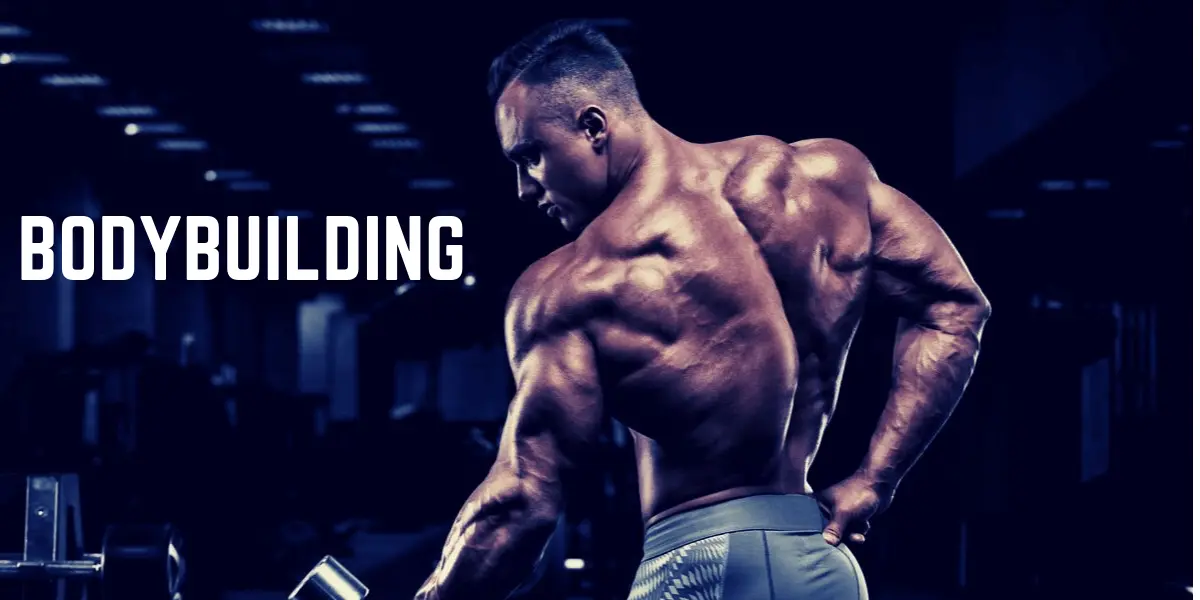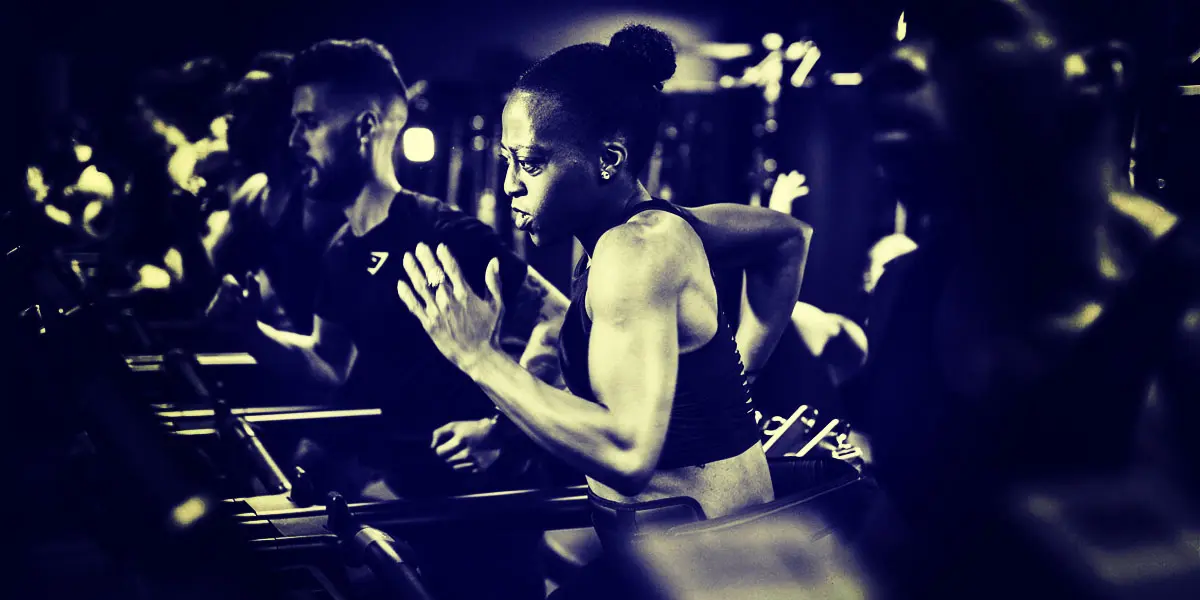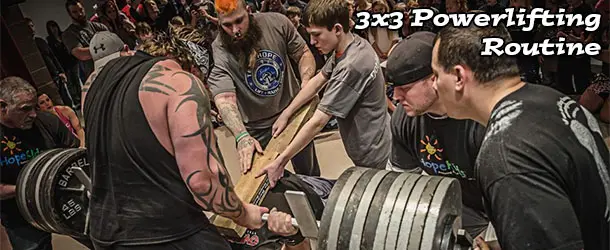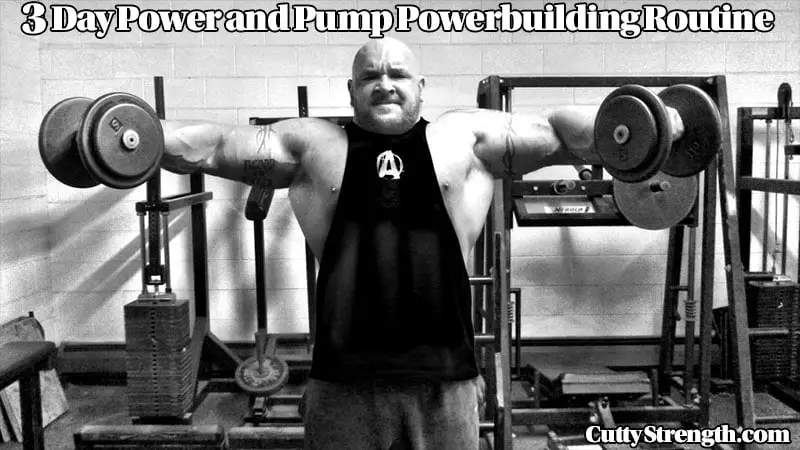
Jump To A Section
| Workout Goal | Build Mass |
|---|---|
| Workout Type | Powerbuilding Split |
| Training Level | Beginner/Intermediate |
| Program Duration | 12 Weeks |
| Days Per Week | 3 |
| Time Per Workout | 45-75 Minutes |
| Equipment Required | Barbell, Dumbbell, Machines |
| Workout PDF | 3 Day Powerbuilding Workout Routine Download |
What is Powerbuilding?
First off, powerbuilding programs are not new. The term powerbuilding is usually used to describe a certain workout program structure. These programs are tailored toward those who want strength and aesthetics. Really, these programs are best for a large majority of the average gym population.
We all want to get stronger and enjoy lifting, but we also want to improve our body composition. Competing is generally out of the question — but that isn’t always the case.
Many of these programs — including this one — starts with a compound movement trained in the lower rep range, and moves onto a bodybuilding focus on accessory lifts. There are many formats, but generally a powerbuilding workout routine will either be a push/pull, upper-lower split, or a powerlifting-style split.
The Difference Between Bodybuilding, Powerlifting, and Bodybuilding
I’ve noticed a trend of other strength athletes migrating to the wonderful sport of powerlifting. Whether they are tired of the culture, the subjective judging criteria of bodybuilding, or even the politics involved in the sport… athletes are turning to a powerbuilding way of training. Nothing beats breaking personal records, building muscle, and training with the intent of a bodybuilder.
Bodybuilding

Bodybuilders burn off any nonessential body fat, train for hypertrophy, and focus on creating a symmetrical aesthetic body.
Bodybuilding sculpts your body by keeping meticulous track of the caloric intake, performing a lot of conditioning, and lots of volume for hypertrophy. This allows the body to build muscle while keeping fat gain minimal.
Powerlifting



Powerlifters tend to have more body fat than bodybuilders… but that isn’t always the case. Truth be told, food makes you stronger. Food is anabolic. Food builds muscle and improves your strength, but it will pack on the fat.
It’s a double edged sword.
Powerlifters train to lift the most weight possible in the squat, bench, and deadlift. Competition includes weight classes in which you have three attempts at the squat, bench, and deadlift to obtain your highest total. Your total is the combination of all three of your lifts.
Bodybuilding focuses on building muscle through high reps. Powerlifting focuses on your nervous system by improving your strength.
Powerbuilding
Powerbuilding is what the average gym goer is looking for — a better looking physique, to be able to carry all of the groceries in one trip, and to be able to bench three wheels per side.
They focus on eating nutritious foods, but they aren’t worried about gaining a small amount of fat in exchange for stronger lifts. They may slack on their cardio, but they also know the better their conditioning, the more weight they can lift.
Powerbuilding is fun because you can “chase the pump” like a bodybuilder, but you can bend bars and break PRs training like a powerlifter.
Goal Of This 3 Day Powerbuilding Workout
There aren’t any promises that this powerbuilding routine will make you a top-level athlete, but you will certainly become one of the strongest people in your gym with consistent training.
You are going to learn nutrition from a bodybuilder’s perspective, you’ll build a solid foundation of strength, and you’ll pack on mass while you improve in all of your lifts. Even if you do not have a desire to get on a stage or compete, a strong muscle is big and a big muscle can be strong.
Are you ready to start cracking sidewalks?
Diet and Nutrition for Powerbuilding



When it comes to dieting as a powerbuilder, you will get the most out of this workout if you slow bulk. That means instead of eating whatever you can fit in your mouth, you calculate your TDEE and eat a few hundred extra calories per day.
This is going to allow you to build strength and muscle without packing on too much fat. Since your goal is to get stronger and build muscle without wrecking your physique, you’ll need to start counting your calories and keeping on track if you want to see the most improvement.
That means you need to start logging your food — there’s no other way around this. Otherwise, you risk spending weeks trying to build muscle and fail because you simply aren’t eating enough. Or worse, you could gain a lot more fat than you bargained for.
Protein
Eating enough protein is important for building muscle. Aim to eat around one gram of protein per pound of bodyweight. Realistically, if you weigh 200+ pounds, aiming to get close to 170 grams of protein is a good start.
Great Protein Sources
- Eggs – whole or egg whites
- Fish – salmon, tilapia, tuna, cod
- Chicken – boneless skinless breasts and thighs
- Turkey
- Pork – loin
- Beef – ground beef, steak
- Beans
- Dairy – cottage cheese, milk, yogurt
- Nuts, Nut Butters, and Seeds
Related: 11 Cheapest Good Protein Sources
Carbohydrates
Carbohydrates fuel our body and allow us to perform at optimal levels. Carbs caught a bad rap due to everything being full of sugars. Fuel your body with healthy, nutritious carbohydrates.
Great Carbohydrate Sources
- Quinoa
- Bananas
- Oats
- Buckwheat
- Potatoes – sweet, yellow
- Oranges
- Blueberries
- Grapefruit
- Kidney Beans
- Chick Peas
- Rice – black, brown, white
- Cottage Cheese
Related: The Science Behind Low-Carb Diets for Fat People
Fats
Even more demonized than carbohydrates, high-fat foods can be nutritious and help to aid in hormone function, memory, and the absorption of many specific nutrients.
Healthy fats create a feeling of satiety — meaning you stay fuller for longer. They slow down the digestion of carbohydrates and add so many wonderful flavors to food. The most healthy fats are monounsaturated and polyunsaturated fats — including omega-3 and omega-6 fatty acids.
Great Fat Sources
- Avocado
- Dark Chocolate
- Chia Seeds
- Eggs – whole
- Fatty Fish – fresh tuna, herring, mackerel, salmon, sardines, trout
- Nuts
- Nut and Seed Butter
- Olives
- Olive Oil
- Yogurt
- Dairy – cheese, sour cream, milk, butter



Struggling to Gain Weight?
Do you eat a lot and still struggle to add weight? It’s time to add some flavor and fats to your meals. These will increase the flavor in your foods, won’t be voluminous, and I mean who doesn’t like some extra butter or sour cream?
If you keep your weight consistent and need some tips to add calories into your diet, here are some of the best and healthiest ways to do so:
- Butter
- Cream cheese
- Sour cream
- Whole milk
- Heavy cream
- Cheese on everything
- Protein shakes
- Peanut butter
- Olive oil
- Extra dressing
Cooking
You really need to learn to cook. If you refuse to cook but eat a lot of prepared meals, adding a glob of sour cream to some mashed potatoes or using whole milk in your protein shakes are an easy way to boost your nutrition and calories.
Doing this is much healthier than running to your local fast food joint to get food. You’ll feel much better, have more energy, and you won’t have all of those upset stomachs.
Note: A little bit goes a long way, so be sure to know how many calories you are adding. Keep a set of measuring spoons and cups so you can get an accurate count of what you’re eating. Fats are calorie dense and it’s easy to get an extra 500 calories into your meal.
Cardio for Powerbuilding



Your level of conditioning is one of the most important things you can work on to improve your lifts, endurance, and stamina. Improving your conditioning will improve other areas of life outside of the gym. This particular routine focuses a bit on conditioning, core strength, and mobility.
Once you start lifting relatively heavier weights, your form will start to break down due to muscle weakness, lack of conditioning/muscle endurance and mobility issues. That’s what we are addressing.
Warming Up
For your pre-workout warm up, start by walking for 3 minutes and follow-up with a 30 second balls-to-the-walls high intensity sprint. Finish off with 90 seconds of walking. This “shock” is going to prime your body to train hard and helps get your core body temperature up.
Post Workout Conditioning
I’m not big on citing research materials and I sure as hell am not interested in doing the scientific leg work, but doing high intensity interval training will help improve your muscle and strength gains.
Cardio Plan:
- 5 minutes brisk walking
- 30 seconds jogging
- 30 seconds walking
- 30 seconds sprinting
- 30 seconds walking
- 45 seconds sprinting
- 1 minute walking
- 1 minute jogging
- 1 minute walking
- 30 seconds full sprinting
- 1.5 minutes walking slowly tapering down to finish
Related: 4 Steps to Starting High Intensity Interval Training
Cardio and Conditioning Tips
This sounds like some special formula but it isn’t — this is just a template. If you don’t follow it exactly, or you modify it… that’s fine! What I want to make you aware of is warming up and priming your body for high intensity training.
Don’t get stuck on the numbers, if you have poor conditioning, add longer walk (resting) periods and strive to recover faster. I used to be winded simply going to get the mail — I know what it’s like to start from the bottom.
How to Program for Powerbuilding
Here is a sample schedule for this routine:
- Monday – Day 1
- Tuesday – Off
- Wednesday – Day 2
- Thursday – Off
- Friday – Day 3
- Saturday – Off
- Sunday – Off
The actual days you train do not matter, the time off does. For example, I personally train Friday, Sunday, and Tuesday.
Recovery is number 1 priority, so don’t try to make this a 6 day routine or never take days off.
3 Day Powerbuilding Workout Routine
| Day 1 | ||
| Exercise | Sets | Reps |
|---|---|---|
| Squats | 5 | 5 |
| Military Press | 5 | 8 |
| Stiff Leg Deadlifts | 3 | 20 |
| Lat Pull Downs | 4 | 10 |
| Reverse Hyperextensions | 4 | 12 |
| Cross Body Hammer Curls | 5 | 15 |
| Day 2 | ||
| Exercise | Sets | Reps |
|---|---|---|
| Bench | 5 | 5 |
| Dumbbell Incline Bench | 3 | 12 |
| Barbell Rows | 4 | 12 |
| Skull Crushers | 4 | 15 |
| Rear Delt Lateral Raise | 4 | 12 |
| Reverse Hypers | 4 | 12 |
| Day 3 | ||
| Exercise | Sets | Reps |
|---|---|---|
| Deadlifts | 5 | 5 |
| 1 Arm Dumbbell Rows | 4 | 8 |
| Face Pulls | 4 | 15 |
| Dumbbell Shrugs | 3 | 15 |
| Seated Close Grip Row | 3 | 15 |
| Curls | 4 | 15 |
Workout Tips
Form
Take care to perform your lifts with the best form you have. When lifting heavy, your form is going to break down. Train yourself to lift with as perfect of form as possible no matter what weight you lift. This ensures you keep your risk of injury minimal and improves the efficacy of your training.
Progressive Overload
Your goal here is to strive for progression. If you achieve every rep of every set at your desired weight, add five to ten pounds to the bar next week. Keep a training log so you have a record of what you’ve lifted, and always strive to improve whether it’s 5 pounds or one more rep.
Sharing is caring, and as always leave any comments or questions below!



Hey Cutty, this program looks really good. A couple questions:1. what are cross body hammer curls?(are they just hammers to the chest?) 2.can I get some forearm and calf exercises in there?(maybe on off days?) 3. Is there anything you’d change in the program now? 4.this is full body right? 5. Do I need to do the exercises one after the other like they are written? Thank you Cutty!
Yes on the hammer curl question. Instead of directly in front of you, swing in and up towards your chest. You’ll feel a huge differece.
Calves and forearms are small muscles, add them in if you feel they need work. I’ve never had any clients need to add it in but it wouldn’t hurt.
The routine is based off of basic lifts and progression, there’s no need to change what works. But as long as you focus on progression you can pretty much do whatever you’d like to.
This routine is based off of a powerlifting setup – you have your squat day, bench day, and deadlift day with exercises that help build that lift.
The only part of order you need to follow is get the big compound lifts done first. I would say always do at least the first exercise (squat, bench, deadlift) first and then do whatever after those. This ensures you are fresh and not fatigued and as injury prone than if you were to do them towards the end of the routine.
Good luck and keep me updated!
Thanks a lot Cutty! I’ll keep you updated!
Remember that mindset is everything. Make lofty goals and obsess about them until you achieve them.
I hit my (at the time) life goal of a 605 deadlift after invoking so much emotion and desire to achieve it. Visualize your goals and put in the work needed to get there.
Good luck!
Hey Cutty, me again :D sorry to bother you but do I need to do pause benching?(I won’t compete in powerlifting) (for hypotrophy).
Pause benching is a great tool for sticking points and to build more strength off of the chest. I would recommend only using it when you start hitting sticking points of plateaus. It doesn’t hurt to do them whether you compete or not.
Sorry I have so many questions but are the rows like bent over or like pendelay? Are the reverse hypers weighted?
And can I replace the SLDL with good mornings?
No worries about questions, sorry I have been busy and unable to answer them quicker.
If you are comfortable doing Pendelay rows, they are great for building explosive power. The bent over rows I’m talking about are just regular bent over barbell rows. Do both, one week do one type and the next week another.
If you can do good mornings, those are much better than SLDL for hamstrings. You could also do like the rows and switch them up as you go. As long as you note the weights used and strive for progression, either will work just fine.
Hey Cutty, I’m very interested in starting this program, I had neck surgery years ago and had cancer about two years ago, I’m just getting back into the gym after a 2 year layoff. I’ve been going strong for about 6 months, and noticing I’ve gained a lot of my strength back ( muscle memory is real) but not where I used to be, BP was 600 now 505, DL was 700 now 550 and SQ was 685 now 500, do you think this program will help me get nearer to what I was lifting before, keep in mind I’m trying to lose about 75 pounds of the weight I’ve put on from my hiatus….. Would this program help
I think the volume will help build the endurance and conditioning back up for sure.
If you start running into being unable to progressively add weight, you’ll definitely have to switch up to periodization.
Hi Cutty, I have just started using this workout plan last week. What are your reasons to making the 1 arm DB row to a 5×5 instead of for example a 3×10?
If you’re not struggling to get the 5th rep on your set, you are using way too light of a weight.
It’s meant for big, heavy dumbbell rows. Not 30 pound rows.
Thank you Cutty for this powerbuilding program! Im on my 5th week with steady gains and many people are noticing i am becoming more muscular. Mind you ive been lifting for years and im in my upper 40’s. I love the pre and post workout conditioning. Also the popping in my right shoulder was fixed after about 2 to 3 weeks in. My squats and deads keep increasing 5lbs a week but my presses have stalled maybe getting a little weaker but im also getting more cut at the same time. Any advice on my presses stalling? Thanks, Dr. Lou
Dr. Lou
Thank you for the kind words and great job on the progress. Pressing has always been a weak point for me and there’s a few options you could try. One, I’d invite you to check out my Build a Bigger Bench article. It’ll give you a lot of information on fixing form and addressing weak points.
After you’ve read that and you still are having issues, I would either drop the weight down some (say 90% of your working weight now) and start over. Maybe increase warm ups and try different tempos. Paused bench works well for me, even if I add in one or two paused reps (one in the beginning, one in the end) and really hammer down on form. The smallest rolling of your wrists can ruin your leverage.
Let me know how this works for you!
Thank you for the advice and the reminder about rolling the wrists. I used to pay attention to that more. I will keep it in mind when i do chest day this coming Tuesday. I did bench again before i got ur reply and i did a little better with the same weight I used the previous week. Thank you for your help!
I’m glad to hear that. Keep me posted on your progress!
Hi Cutty, I am very keen on starting this programme but got a few questions. Can add like some cardio on my days off
Sammy, I highly recommend adding cardio whenever you can.
For the main lifts (bench, squat, dead) you list 3 x 8. Should I use same weight for all 3 sets and go for AMAP on last set?
Thanks
You could do the regular pyramid way like most people do, or you can use the same weight every working set. I prefer using the same weight due to being easier than having to load the bar, and you get a completely different feeling in set 3 than you would if you upped the weight every time. I feel it’s easier for me and definitely my favorite way.
If you can rip out some extra reps on the AMAP part, that’s definitely good. You don’t have to go until you’re doing bad form just to get a half rep, but put some effort into it and you’ll notice a difference.